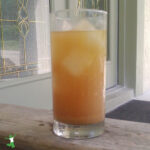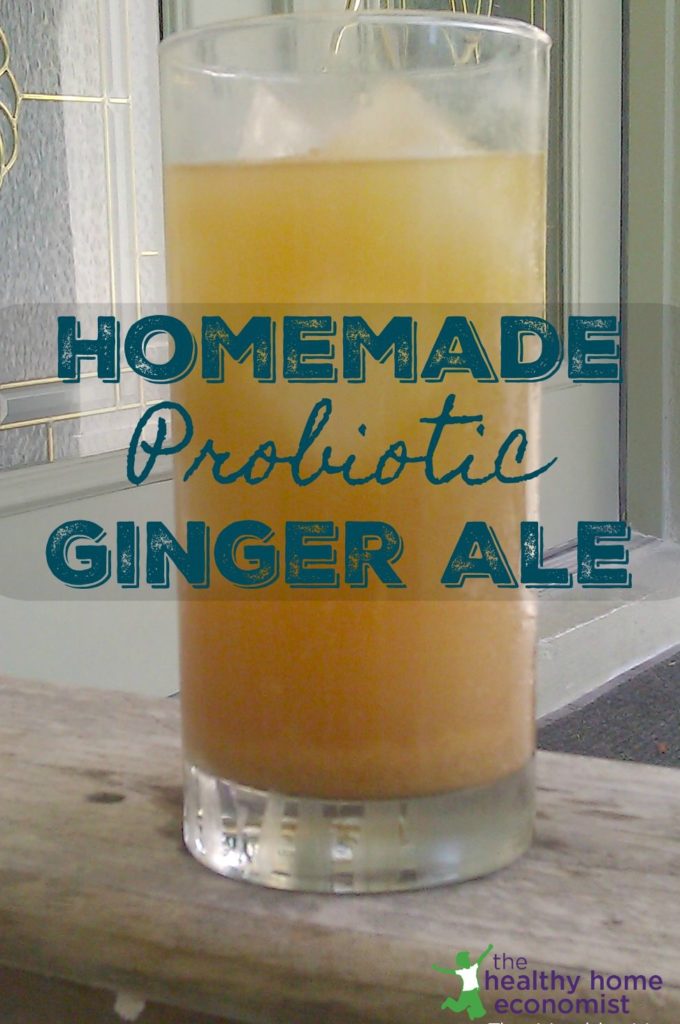Table of Contents[Hide][Show]
A traditional recipe for homemade ginger ale that is lightly fermented with cultured starter, which adds beneficial probiotics and enzymes for digestive benefits as well as delicious taste!

Ginger ale is one of the easiest drinks to whip up at home in a matter of minutes.
The bonus of making ginger ale yourself is that you can ferment it.
This means it is loaded with beneficial bacteria known as probiotics. In addition, traditionally brewed ginger ale is rich in enzymes and has enhanced nutritional value.
Fermentation of grains, fruits and herbs into refreshing and delicious drinks is nearly universal in ethnic cuisines, according to the Nourishing Traditions cookbook, from which this beverage recipe is adapted.
Sadly, the emphasis on convenience in our modern society means that this practice is largely forgotten with the continued popularity of commercial sodas.
Modern versions of ancestral beverages offer no redeeming nutritional benefit.
Worse, the consumption of these sugar-laced or artificially sweetened drinks encourages obesity and other chronic ailments.
Soda really can be healthy! Learning traditional preparation techniques is all that is required.
Preparation Tips
Raw liquid whey is the suggested starter for this beverage and the one I’ve used for decades with great success.
Please refer to this article on the various methods for making raw whey at home for additional details to determine which approach works best for you.
Note that you cannot buy raw whey commercially, although some small dairy farms have it available for purchase.
If a dairy allergy is present, a quarter cup of ginger ale starter or “ginger bug” or water kefir is a simple substitution.
Other ideas for dairy-free fermentation are detailed in the linked article.
While sucanat (pure dried cane juice) is the recommended sweetener, jaggery is a healthy option as well that produces great results.
Raw honey also works for those on gut healing diets such as GAPS. Note that the fermentation will generally occur a bit more quickly using it. I suggest reducing the fermentation time to 1-2 days if using raw honey.
A secondary fermentation using bottles to add additional fizz is optional, but a great idea if you have the time and inclination!

Homemade Ginger Ale Recipe
A traditional recipe for homemade ginger ale that is lightly fermented with cultured starter which adds beneficial probiotics and enzymes to the brew.
Ingredients
- 2 quarts filtered water
- 1/2 cup lime juice freshly squeezed, about 3 limes (preferably organic)
- 2 tsp ground ginger or 2 Tbsp freshly chopped ginger
- 1/3 cup sucanat
- 1 tsp sea salt
- 1/4 cup liquid whey do not use powdered whey
- 1-2 Tbsp raw honey optional
- pinch green stevia powder optional
Instructions
-
Mix all ingredients together thoroughly in a half gallon glass jar. Be sure to leave 1 inch at the top else the soda will get moldy instead of ferment. Affix a secure lid.
-
Leave at room temperature on the counter to culture for 2-3 days and then refrigerate. Homemade ginger ale is mildly fizzy. You can then mix with sparkling mineral water post-fermentation to add even more fizz if desired.
-
Alternatively, you can bottle the homemade soda and leave on the counter for an additional 1-2 days before refrigerating to produce a very fizzy beverage. Be sure to let the bottled soda get very cold before opening. Opening in the sink is a good idea.
-
If the finished homemade ginger ale is not sweet enough for your taste (usually necessary for those coming off a soda habit), add a pinch of optional stevia or stir in a small amount of raw honey.

Other Fermented Beverages to Try!








Hi,
I am just wondering if I use honey in the different fermented drinks (we are on GAPS diet) do I need to ferment the drinks longer? I am going to try the lemonade and ginger ale. Also, do you know if I can use honey in most fermented drinks like the 2 mentioned above and other sodas?
Thanks a ton!
Is powdered ginger necessary or can fresh ground gingerroot be used? Also what about anoher form of sweetner, like Rapadura?
during the 2-3 initial days on the counter, do you cover the brew with a lid? or just cover with a cloth? thank you!!
Ok, I made this for the first time last week, and let it ferment for 2 days, no fizz, let it set for another day, got green mildew on top. Threw it out, and made another batch. THis time I left more than an inch of space from top of jar. I let it ferment for 3 days, and absolutely no fizz whatsoever. I used whey left from making neufchatel, which I added rennet to, with raw goat’s milk, . Could the rennet I used makeing cheese effect the whey? I am new to fermenting things and am unclear as to what is happening. If it is not fizzy, does that mean it is not fermented? I would think so. I know it won’t be real fizzy, but mine is completely flat. Thanks for any advice!! I really want this to work., as my hubby loves ginger ale.
For fermenting you need to use sour whey (the byproduct of cultured dairy like yogurt or buttermilk). If you use sweet whey (the byproduct of most cheese making), I don’t think it will work because it isn’t acidic
As an edit to my earlier comment, I realized its not the acidity that matters in this case for fermentation( it’s important when soaking grains, etc.) , but the presence of probiotics in the whey (as a result of the cultured dairy)
I have made this for the first time, it is on day two of fermenting. So excited to try it! I hope it is as good as I think it will be. Should I cover it though, or will that cause fermenting problems?